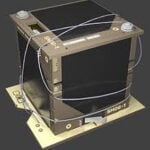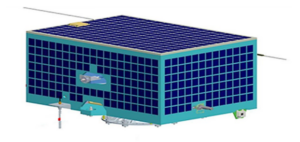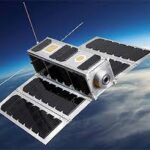AMSAT NEWS SERVICE
ANS-356
The AMSAT News Service bulletins are a free, weekly news and information service of AMSAT, The Radio Amateur Satellite Corporation. ANS publishes news related to Amateur Radio in space including reports on the activities of a worldwide group of Amateur Radio operators who share an active interest in designing, building, launching and communicating through analog and digital Amateur Radio satellites.
The news feed on https://amsat.org publishes news of Amateur Radio in space as soon as our volunteers can post it. Please send any amateur satellite news or reports to: ans-editor at amsat dot org. You can sign up for free e-mail delivery of the AMSAT News Service Bulletins via the ANS List; to join this list see: https://www.amsat.org/mailman/listinfo/ans
In this edition:
- SMOG-P and ATL-1 Designated Magyar-OSCAR 105 (MO-105) and Magyar-OSCAR 106 (MO-106)
- CAMSAT CAS-6 Satellite Launched
- FCC Formally Adopts Proposals to Remove Amateur 3-GHz Band, Invites Comments
- FCC Considers NPRM for 5.9 GHz Band Rules
- Changes to AMSAT-NA TLE Distribution for December 19, 2019
- AztechSat-1 CubeSat to Demonstrate Intra-Satellite Communication
- AMSAT CW Day, January 1, 2020 is Just Ahead!
- ESA’s OPS-SAT Flying Laboratory Launched
- AMSAT-LU – Dec-15 AMSAT-LU NEMO-1 Buoy Report
- Upcoming Satellite Operations
- ARISS News
- Satellite Shorts from All Over
SMOG-P and ATL-1 Designated Magyar-OSCAR 105 (MO-105) and Magyar-OSCAR 106 (MO-106)

On December 6, 2019, the Technical University of Budapest SMOG-P and ATL-1 PocketQubes were launched on an Electron launch vehicle from the Mahia Launch Complex in New Zealand. SMOG-P and ATL-1 were developed as part of the university curriculum and operated in cooperation with the HA5MRC Technical University amateur radio club. The satellites carry spectrum monitoring payloads and are currently active.
At the request of the Technical University of Budapest, AMSAT hereby designates SMOG-P as Magyar-OSCAR 105 (MO-105), and ATL-1 as Magyar-OSCAR 106 (MO-106). AMSAT congratulates the owners and operators, thank them for their contribution to the amateur satellite community, and wish them a long mission and continued success on this and future projects.
[ANS thanks Drew Glasbrenner, KO4MA, AMSAT VP Operations / OSCAR Number Administrator for the above information.]
CAMSAT CAS-6 Satellite Launched

CAMSAT’s amateur radio payload CAS-6 piggybacked on a technology test satellite TIANQIN-1 was successfully launched on December 20, 2019 at the Taiyuan Satellite Launch Center of China using a CZ-4B launch vehicle. The primary payload of this launch is China-Brazil Earth Resources Satellite CBERS-4A. Specifications for the satellite are as follows:
| Satellite Name | CAS-6/TIANQIN-1 |
|---|---|
| Orbit Type | Sun Synchronous |
| Apogee | 629 km |
| Inclination | 97.89 degrees |
| Period | 97 minutes |
| Satellite Architecture | Micro-satellit |
| Mass | 35 kg |
| Stabilization | 3-axis |
| Amateur Radio Callsign | BJ1SO |
| VHF Antenna | 1/4 wavelength monopole |
| UHF Antenna | 1/4 wavelength monopole |
| CW Telemetry Beacon | 145.910 MHz 17 dBm |
| AX.25 4.8K Baud GMSK Telemetry | 145.890 MHz 20 dBm |
| U/V Linear Transponder Downlink | 145.925 MHz 20 dBm |
| U/V Linear Transponder Uplink | 435.280 MHz |
| U/V Linear Transponder Bandwidth | 20 KHz Inverting |
The satellite is currently in orbit testing, the amateur radio payload is expected to be operational in about three days.
[ANS thanks Alan Kung, BA1DU for the above information.]
Need new satellite antennas? Purchase Arrows, Alaskan Arrows, and M2 LEO-Packs
from the AMSAT Store. When you purchase through AMSAT, a portion of the proceeds
goes towards Keeping Amateur Radio in Space.
https://amsat.org/product-category/hardware/
FCC Formally Adopts Proposals to Remove Amateur 3-GHz Band, Invites Comments
At its December 12 meeting, the FCC formally adopted a Notice of Proposed Rulemaking (NPRM) in WT Docket 19-348 and invited comments on its plan to remove “existing non-federal secondary radiolocation and amateur allocations” in the 3.3 – 3.55 GHz band and relocate incumbent non-federal operations. The FCC said it’s seeking comment on appropriate “transition mechanisms” to make that happen. ARRL has indicated that it will file comments in opposition to the proposal. The amateur 9-meter allocation is 3.3 – 3.5 GHz. The NPRM comes in response to the MOBILE NOW [Making Opportunities for Broadband Investment and Limiting Excessive and Needless Obstacles to Wireless] Act, approved by the 115th Congress to make available new spectrum for mobile and fixed wireless broadband use.
“By proposing to delete the existing non-federal secondary allocations from the 3.3 – 3.55 GHz band, we are taking an important initial step towards satisfying Congress’s directives and making as
much as 250 megahertz of spectrum potentially available for advanced wireless services, including 5G,” the FCC said in the Introduction to its NPRM.
Currently, the entire 3.1 – 3.55 GHz band is allocated for both federal and non-federal radiolocation services, with non-federal users operating on a secondary basis to federal radiolocation services, which have a primary allocation, the NPRM explains.
The FCC said it is seeking comment on relocating non-federal licensees to another band. With respect to amateur operations, the FCC invited comments on whether sufficient amateur spectrum exists in other bands that can support the operations currently conducted at 3.3 – 3.5 GHz. The 3.40 – 3.41 GHz segment is earmarked for amateur satellite communication. “We seek comment on the extent to which the band is used for this purpose, whether existing satellites can operate on other amateur satellite bands, and on an appropriate timeframe for terminating these operations in this band,” the FCC said. If non-federal licensees are relocated to 3.1 – 3.3 GHz band, the FCC proposes that they continue to operate on a secondary basis to federal operations, consistent with current band allocations.
Some comments began to arrive before the FCC formally adopted the NPRM, as it points out in a footnote. Kevin Milner, KD0MA, the secretary/treasurer of the Ski Country Amateur Radio Club in Colorado, has argued that the club’s equipment cannot be re-channeled below 3.4 GHz, and the club is seeking relocation costs. Devin Ulibarri, W7ND, told the FCC that amateur networks in the current band cannot move easily into other amateur allocations because there is no readily available commercial equipment to support the bandwidth, the FCC recounted.
In the event the proposed amendments are adopted, the FCC “seeks comment on relocation options and on transition and protection mechanisms for incumbent non-federal operations.”
[ANS thanks the ARRL for the above information.]
FCC Considers NPRM for 5.9 GHz Band Rules
Also at its December 12 meeting, the FCC considered another NPRM in WT Docket 19-138 that would “take a fresh and comprehensive look” at the rules for the 5.9 GHz band and propose, among other things, to make the lower 45 MHz of the band available for unlicensed operations and to permit “cellular vehicle-to-everything” (C-V2X) operations in the upper 20 MHz of the band. The FCC is not proposing to delete or otherwise amend the amateur allocation, which would continue as a secondary allocation.
The Amateur Radio Emergency Data Network (AREDN) has offered its voice in challenging the FCC proposals on the two bands, saying their adoption would “eliminate our use of the most-effective resource hams have to build its networks.”
“The AREDN Project is able to leverage low-cost commercial devices solely because they are designed to operate on adjacent allocations, AREDN said on its website. “Moving to other allocations would be difficult if not impossible without a complete redesign, manufacture, purchase, and installation of new custom amateur hardware and software…, raising the price out of reach for the typical ham.”
Interested parties may file short comments on WT Docket 19-348 via the FCC’s Electronic Comment Filing Service (Express). Visit the FCC “How to Comment on FCC Proceedings” page for information on filing extended comments.
[ANS thanks the ARRL for the above information.]
Changes to AMSAT-NA TLE Distribution for December 19, 2019
The following Amateur Radio satellites have been added to this week’s TLE distribution:
- ATL 1 – NORAD CAT ID 44830 (Rocket Lab launch, 12/06/2019).
- TRSI-Sat – NORAD CAT ID 44831 (Rocket Lab launch, 12/06/2019). [2]
- Duchifat 3 – NORAD CAT ID 44854 (ISRO launch, 12/11/2019). [1]
- OPS-SAT – NORAD CAT ID 44878 (ESA launch, 12/18/2019).
Thanks to Nico Janseen, PA0DLO, for satellite identifications.
Note:
1. Duchifat 3 is being used as the TLE name. Duchifat 3 is the name used by the students who built it, per the university website.
2. TRSI-Sat is not transmitting at the present time. TLEs will be provided until it is determined that it has failed.
[ANS thanks AMSAT Orbital Elements Manager Ray Hoad, WA5QGD, for the above information.]
AztechSat-1 CubeSat to Demonstrate Intra-Satellite Communication
The AztechSat-1 CubeSat, which traveled to the International Space Station (ISS) last weekend on the 19th Space-X Commercial Resupply Services (CRS-19) mission for NASA, will listen for emergency messages in the 439 MHz range and retransmit them for amateur radio operators to copy on the 437.300 MHz downlink using the Winlink protocol, once the CubeSat has been placed into orbit. The satellite is a project of Mexico’s Universidad Popular Autónoma del Estado de Puebla (UPAEP). Aztechsat-1 is set for deployment from the International Space Station in late January.
“The primary objective of the project is to establish communication with the commercial GlobalStar satellites in order to improve data transmission to Earth,” a UPAEP news release said. AztechSat-1 will create a saturation map of 435 – 438 MHz by listening for the whole orbit and returning captured data to the ground station on the 437.300 MHz amateur radio downlink (9k6 GMSK or FSK) plus a 1600-MHz Global-Star link. Emergency messages received via Globalstar to the AztechSat-1 ground station will be shared on the project’s website. A certificate will be available for amateur stations receiving the emergency message(s) and reporting these for confirmation by the AztechSat-1 team.
Details are on the AztechSat-1 website and on the IARU Amateur Radio Satellite Communication page.
The project is part of NASA’s CubeSat Launch Initiative, which offers universities, high schools and non-profit organizations the opportunity to fly small satellites. “Innovative technology
partnerships keep down the cost, providing students a way to obtain hands-on experience developing flight hardware,” a NASA report said.
NASA explained, “The investigation demonstrates communication within a satellite network in low-Earth orbit. Such intra-satellite communication could reduce the need for ground stations, lowering the cost and increasing the number of data downloads possible for satellite applications.”
[ANS thanks ARRL for the above information.]
AMSAT CW Day, January 1, 2020 is Just Ahead!
 You are cordially invited to take part in AMSAT CW Activity Day 2020 sponsored by AMSAT for all radio amateurs throughout the world. The 2020 event will be held in memory of Larry Brown, W7LB, and Keith Pugh, W5IU. Among their many contributions to AMSAT, they were the AMSAT 20-meter net for many years.
You are cordially invited to take part in AMSAT CW Activity Day 2020 sponsored by AMSAT for all radio amateurs throughout the world. The 2020 event will be held in memory of Larry Brown, W7LB, and Keith Pugh, W5IU. Among their many contributions to AMSAT, they were the AMSAT 20-meter net for many years.
Participation is easy. Just operate CW through any Amateur Radio satellite on 1 January 2020. Use of straight keys or bugs is encouraged but not required. If you use AO-7, please observe the QRP rules currently in effect for that 45-year-old satellite. May it be with us for many years to come!
[ANS thanks Raphael Soifer, W2RS, AMSAT Senior Advisor for the above information.]
ESA’s OPS-SAT Flying Laboratory Launched
 On December 18 2019 ESA launched a first-of-its-kind space laboratory, OPS-SAT. The satellite lifted off from Europe’s Spaceport in Kourou, French Guiana aboard a Soyuz-Fregat rocket. The small, low-cost, test satellite has been specifically designed for operational experimentation in space, and includes the most powerful flight computer on-board any current ESA spacecraft.
On December 18 2019 ESA launched a first-of-its-kind space laboratory, OPS-SAT. The satellite lifted off from Europe’s Spaceport in Kourou, French Guiana aboard a Soyuz-Fregat rocket. The small, low-cost, test satellite has been specifically designed for operational experimentation in space, and includes the most powerful flight computer on-board any current ESA spacecraft.
Consumer electronics have gone through a revolution over the last 30 years with computers becoming ever faster, smaller and better. But when it comes to million- or even billion-euro satellites, their on-board hardware and software have not seen this revolution due to the risk of testing new technology in flight.
As spacecraft managers dare to fly only tried-and-tested hard and software in the harsh conditions of space, innovation on the operational side of satellites is a very slow-moving process. This is where OPS-SAT steps in, bringing down the barriers to spacecraft operations it provides a chance to safely test out new mission control techniques.
Anyone can apply to become an ‘experimenter’ and test their innovative software and new mission operations techniques in space. OP-SAT provides technology for future missions and paves the way for satellites to further evolve with minimum risk. Complete information is available at https://tinyurl.com/ANS-356-OPS-SAT.
[ANS thanks the European Space Agency for the above information.]
AMSAT-LU – Dec-15 AMSAT-LU NEMO-1 Buoy Report
On Tuesday 10-Dec at 5AM in the Port of Mar del Plata, Argentina, an AMSAT-LU team started the Buoy NEMO-1 operation.
There were LU1ESY and LU3ATZ (land-sea communications), and embarked on the ship ‘Porteño’ LU1DCX, LU2AOP, LU6EI and LU4BMG. Photo: http://amsat.org.ar/nemolanz.jpg
Communications were made thru the ‘Repelata’ (RepeCan), an effective FM VU repeater made by LU9ATJ, that was raised at 450m height by a captive balloon on the coast.
El Porteño sailed 70 km offshore, finding severe sea conditions and impressive waves. However, NEMO-1 was active and between 0800 and 0900 hours there were WSPR reports from 14 stations around the world: LU3DEI W4DZC LU1KCQ OE5FGL DP0GVN PY1EME PY2GN ZL1RS ZL1ROT DK8FT OE9GHV DK0ABT IW2NKE ZL2005.
Later, a ship maneuver, hit the buoy damaging one of the solar panels. The AMSAT team, helped by ship personnel, recovered the buoy and boarded it on board. After checking the damage, it was decided to abort the mission. NEMO-1 returned home and is in Buenos Aires for repairs, spare parts and reinforcements. Conversations have already been established in Mar del Plata to, once the work is finished, repeat and conclude this adventure.
AMSAT thanks the ‘NEMO Group’, the more than 119 people who helped realize this dream http://amsat.org.ar/certboyae.htm and the Menendez Beety family, who selflessly facilitated accommodation in their house in Mar del Plata.
[ANS thanks AMSAT-LU for the above information.]
Purchase AMSAT Gear on our Zazzle storefront.
25% of the purchase price of each product goes
towards Keeping Amateur Radio in Space
https://www.zazzle.com/amsat_gear
Upcoming Satellite Operations
Shorts:
- Dec 27-30 EM90 N4DCW – vacation style (Twitter: @MWimages)
- Dec 27-30 EL86 K4WPX FM
- Dec 30 EM94 (overnight) – vacation style (Twitter: @MWimages)
- Dec 30-Jan 01 EL87/88 K4WPX FM
Operations Announcements:
- PNW (CN90, CM99, DM09, DN00, DN10, DN20, DN22, DN13, DN23) December 20-23, 2019
Casey, KI7UNJ, is about to embark on 9-grid roving trip through the Pacific Northwest. FM & Linears. Pass schedules posted at https://twitter.com/KI7UNJ/status/1206626476377772032?s=20. Be sure to watch Casey’s Twitter feed for further updates. - Hawaii (BK19, BK28, BK29, BL20) December 21-28, 2019
Alex, N7AGF, is heading back to Hawaii over Christmas. This will be a holiday-style activation, with special emphasis on the grid that got away – BK28. Keep an eye on Alex’s Twitter feed for further announcements: https://twitter.com/N7AGF - NW Iowa XMAS Rove (EN12, EN13, EN22, EN23) December 23-24, 2019
Mitch, AD0HJ, will be visiting his parents in Iowa for Christmas. While there, Mitch will take an extra day to put some Northwest Iowa grids on the air. For a full pass schedule, check https://twitter.com/AD0HJ/status/1207099665465978880. As always, keep an eye on Mitch’s Twitter feed for further announcements at https://twitter.com/AD0HJ - Mississippi River Delta (EL58) January 4, 2019.
Ron AD0DX, Brian KG5GJT, and Robert KE4AL will operate as W5M/mm from the mouth of the Mississippi River (EL58) on January 4th. This will be a 6-hour activation from approximately 1430z to 2030z, on FM and linear satellites. Further information will be posted as it comes available. - Labrador (GO11 +) January 19-27, 2019
Chris VE3FU, Dave VE9CB, and Frank VO1HP will be active as VO2AC in the 2020 CQ160 CW contest, January 24-26, from Point Armour Lighthouse, in Labrador. If time permits before the contest, they may be active on FM satellites from GO11 as VO2AC or VO2AAA. Depending on weather and timing of passes, you might catch them on FM satellites as they make their way from FO93 to GO-11, passing through FO92, GO02, GO13, GO12, and GO22 along the way, but no promises. They will also make the reverse trek on January 27. - Big Bend National Park (DL88) March 16-17, 2020
Ron AD0DX, Doug N6UA, and Josh W3ARD will operate from Big Bend National Park to put grid DL88 on the air. Details will be added here, as they come available, but you are more than welcome to keep an eye on their individual Twitter feeds: https://twitter.com/ad0dx, https://twitter.com/dtabor, and https://twitter.com/W3ARDstroke5
Please submit any additions or corrections to ke4al (at) amsat.org
[ANS thanks Robert Bankston, KE4AL for the above information.]
ARISS News
No school contacts will be scheduled until 2020.
[ANS thanks Charlie Sufana, AJ9N for the above information.]
AMSAT, along with our ARISS partners, is developing an amateur radio package,
including two-way communication capability, to be carried on-board Gateway in
lunar orbit. Support AMSAT’s projects today at https://www.amsat.org/donate/
Shorts from All Over
- Your AmazonSmile Purchases Matter!
AMSAT recently received a quarterly donation of $369.69 thanks to customers shopping at smile.amazon.com. To date, AmazonSmile has donated a total of $4,563.90 to AMSAT. The next time you buy that new radio, toaster, socks, or anything for that matter, make sure you’ve name AMSAT at the beneficiary for your AmazonSmile purchases! [ANS thanks Paul Stoetzer, AMSAT Executive Vice President for the above information.] - Ham Radio Day Aboard the Queen Mary May 2019 Pictures Online
In case you didn’t work W6RO aboard the Queen Mary in Long Island, California, you can still see pictures of the day’s festivities on the Associated Radio Amateurs of Long Beach Facebook page. Enjoy the fun at https://tinyurl.com/ANS-356-W6RO [ANS thanks the Associated Radio Amateurs of Long Beach for the above information.]
In addition to regular membership, AMSAT offers membership in the President’s Club. Members of the President’s Club, as sustaining donors to AMSAT Project Funds, will be eligible to receive additional benefits. Application forms are available from the AMSAT office.
Primary and secondary school students are eligible for membership at one-half the standard yearly rate. Post-secondary school students enrolled in at least half time status shall be eligible for the student rate for a maximum of six post-secondary years in this status. Contact Martha at the AMSAT office for additional student membership information.
73 and remember to help keep amateur radio in space,
This week’s ANS Editor,
Frank Karnauskas, N1UW
n1uw at amsat dot org
